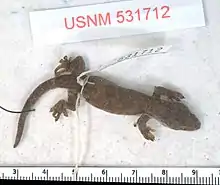Lepidodactylus tepukapili
Lepidodactylus tepukapili is a species of gecko, which is known as the Tuvalu forest gecko and is known in the Tuvaluan language as moko or pili.[1] It is the only recorded vertebrate that is endemic to Tuvalu.[2][3] It has been located on Fuagea (also called Fuakea) and on Tepuka.[2][4]
| Lepidodactylus tepukapili | |
|---|---|
 | |
| Top view of Lepidodactylus tepukapili | |
 | |
| Bottom view of Lepidodactylus tepukapili | |
| Scientific classification | |
| Domain: | Eukaryota |
| Kingdom: | Animalia |
| Phylum: | Chordata |
| Class: | Reptilia |
| Order: | Squamata |
| Family: | Gekkonidae |
| Genus: | Lepidodactylus |
| Species: | L. tepukapili |
| Binomial name | |
| Lepidodactylus tepukapili Zug, Watling, Alefaio, Alefaio, & Ludescher, 2003 | |
Lepidodactylus tepukapili's naming is based upon the Tuvaluan language words for "small lizard" and the island of Tepuka, where specimens were first discovered.[5]
In 2021, the IUCN published its assessment of the Tuvalu forest gecko, classifying it as Critically Endangered due to the ongoing threat of sea-level rise, as related to anthropogenic climate change. The two small low-lying islands on which it occurs average just 2 metres above sea level. IUCN Red List.[6]
References
- Randy Thaman; Feagaiga Penivao; Faoliu Teakau; Semese Alefaio; Lamese Saamu; Moe Saitala; Mataio Tekinene & Mile Fonua (2017). "Report on the 2016 Funafuti Community-Based Ridge-To-Reef (R2R)" (PDF). Rapid Biodiversity Assessment of the Conservation Status of Biodiversity and Ecosystem Services (BES) in Tuvalu. Retrieved 25 May 2019.
- George R. Zug; Dick Watling; Tataua Alefaio; Semese Alefaio & Claudia Ludescher (2003). "A new gecko (Reptilia: Squamata: Genus Lepidodactylus) from Tuvalu, South-central Pacific" (PDF). Proceedings of the Biological Society of Washington. 116 (1): 38–46. S2CID 38959270. Archived from the original (PDF) on 2019-03-04.
- Lepidodactylus tepukapili at the Reptarium.cz Reptile Database
- "Lepidodactylus tepukapili Zug, Watling, Alefaio, Alefaio & Ludescher" (PDF). polynesian diversity. 12 February 2012. Archived from the original (PDF) on 4 March 2016. Retrieved 25 May 2019.
- Lepidodactylus tepukapili. Reptile Database. Retrieved February 2, 2022.
- Tuvalu Sixth National Report to the Convention on Biological Diversity. Ministry of Public Works, Labour, Meteorology and Disaster. Government of Tuvalu. 2020. p. 79. Retrieved February 2, 2022.